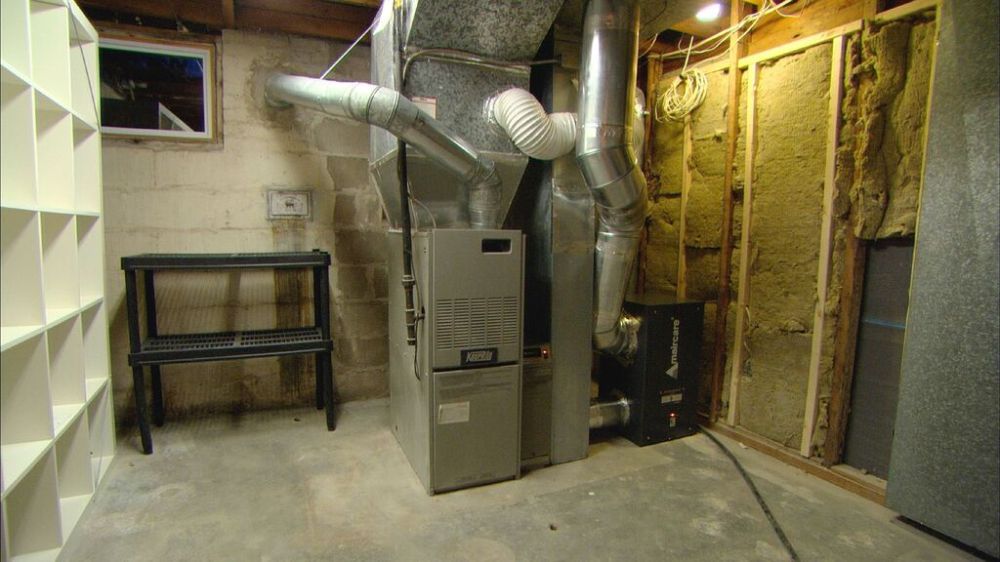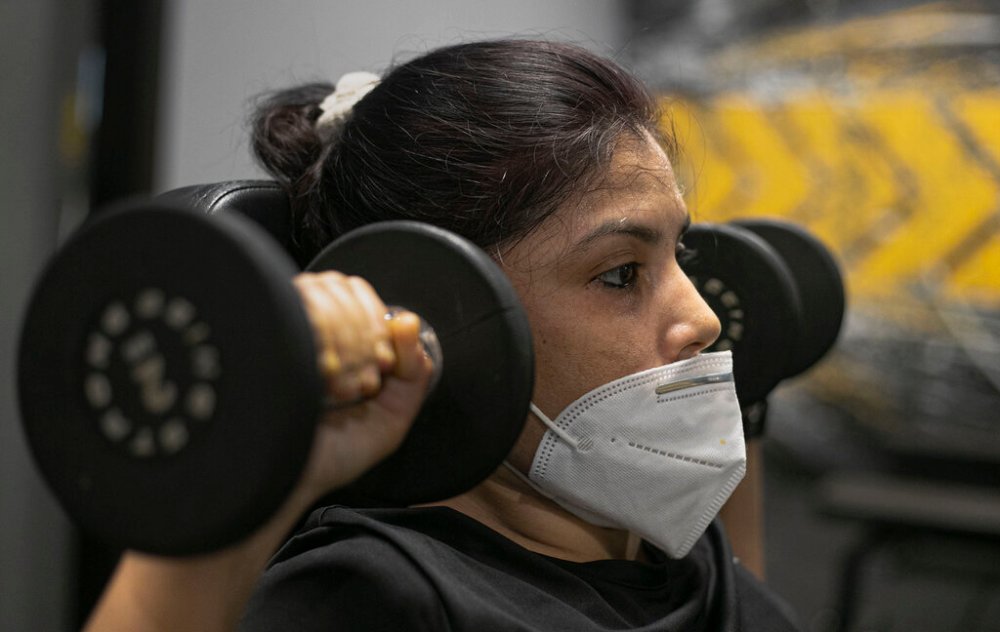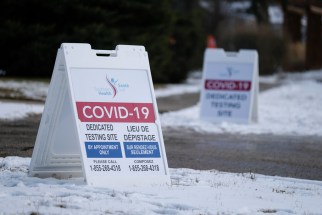Cold, dry truth Manitoba's stale indoor winter air provides an ideal environment for COVID-19 spread, scientists say
Read this article for free:
or
Already have an account? Log in here »
To continue reading, please subscribe:
Monthly Digital Subscription
$0 for the first 4 weeks*
- Enjoy unlimited reading on winnipegfreepress.com
- Read the E-Edition, our digital replica newspaper
- Access News Break, our award-winning app
- Play interactive puzzles
*No charge for 4 weeks then price increases to the regular rate of $19.00 plus GST every four weeks. Offer available to new and qualified returning subscribers only. Cancel any time.
Monthly Digital Subscription
$4.75/week*
- Enjoy unlimited reading on winnipegfreepress.com
- Read the E-Edition, our digital replica newspaper
- Access News Break, our award-winning app
- Play interactive puzzles
*Billed as $19 plus GST every four weeks. Cancel any time.
To continue reading, please subscribe:
Add Free Press access to your Brandon Sun subscription for only an additional
$1 for the first 4 weeks*
*Your next subscription payment will increase by $1.00 and you will be charged $16.99 plus GST for four weeks. After four weeks, your payment will increase to $23.99 plus GST every four weeks.
Read unlimited articles for free today:
or
Already have an account? Log in here »
Hey there, time traveller!
This article was published 04/12/2020 (1836 days ago), so information in it may no longer be current.
COVID-19 thrives in cold, dry settings, making a Winnipeg winter fertile ground for its spread.
Research, increasingly, suggests the virus lingers indoors and infects people through microscopic particles, known as aerosols.
“Cold, dry air is apparently associated with higher rates of transmissibility,” says Andrew Halayko, a University of Manitoba pathophysiology professor specializing in lung diseases.
“In northern regions, as we are in Winnipeg, there’s a bigger impact of temperature and humidity in the atmosphere. So the climate on the outside will affect our conditions in the house.”
The best way for Manitobans to reduce the risk of transmitting the virus is with masks and distancing, but people can also lower the risk of spread within homes, schools and businesses by introducing fresh air.
The fundamentals work
Early on, scientists documented that COVID-19 spreads through respiratory droplets — that word speaks to virus particles that drop down to the floor from noses and mouths, mostly within two metres.
What’s less clear is how the virus spreads through the air. The novel coronavirus is nowhere near as airborne as measles, but lab experiments and real-world super-spreading events suggest it has managed to hang in the air and drift in certain environments.
Outbreaks linked to choir practices, karaoke bars and an Ontario spin class suggest aerosols have infected people more than two metres apart from each other.
Droplet spread is a proven mode of transmission, but experts have increasingly shifted from focusing on surfaces to looking at aerosols as a secondary method of spread.
Cynthia Carr, a Winnipeg epidemiologist who runs EPI Research Inc., says that’s particularly a concern in the Prairies, where aerosols that contain viable virus can linger in the dry air.
“The potential risk is (that) the drier the environment, the more it will pull some of the moisture off our droplets, and allow more to be lighter, and therefore be potentially in the air longer, and maybe go farther,” Carr says.
The good news is that wearing a mask over your nose and mouth cuts down on the spread of both droplets and aerosols, as well as the risk of inhaling them from others.
“Masks are not foolproof,” Carr says. “What they allow you to do is be potentially less than two metres apart. But lab studies still show that even with a mask on, the droplets can still come through; they just can’t come through as far.”

Still, there are ways Manitobans can limit their risk when they enter stores, or have visitors over under exemptions in the current public-health orders, such as home care.
Advice from experts could also help Winnipeggers keep the spread down when the city finally exits code red.
Foggy windows
Anyone who has driven in a Manitoba winter can understand ventilation by thinking about at the two settings for controlling how air moves through their car.
The HVAC control pictogram showing a car with a curved arrow inside indicates air is circulating within the vehicle. The windshield fogs up fairly quickly, due to moisture from occupants’ breath added to the air.
The other mode, illustrated with an arrow entering the car from outside, means fresh, external air is being introduced while the existing air is gradually being sucked out. Ventilation, in other words.
Halayko uses this analogy to explain air exchange.
Circulating air means pushing around the particles lingering in a room, including dust and COVID-19 aerosols. But ventilating dissipates pathogens.
“Drawing in fresh air and eliminating old air is very important,” says Halayko, the Canada Research Chair in Lung Disease and Treatment.
Ventilating occurs naturally outdoors. Droplets dissipate in the open air, even without wind.
Creating that condition indoors means using internal systems to help filter the air, or opening windows to create crosswinds. But using a fan is trickier.
A ventilation system sucks up air, moves it through filters and slowly dries out particles as they approach a furnace, which can eliminate viable virus particles.
Newer homes in Manitoba tend to have heat-recovery ventilation systems, which promote air exchange without leaking heat. Installing a fresh-air intake can help, but Halayko says it’s probably not worth the cost for average Manitobans to renovate their homes.
Placing in a fan in a corner to get air flowing, including near a window, could be helpful. But he advises against aiming a fan directly towards someone. That could make particles lighter without actually killing the virus.
“If (particles) are moving too quickly, and you’re not sitting so far from me, you could be blowing them right into my face.”
Circulating air is believed to have caused an outbreak at a restaurant in China, where the virus spread from one part of the room to a corner near an air conditioner, but did not infect people in the middle.
However, Halayko says people living in apartment buildings and care homes shouldn’t be worried about getting COVID-19 from a neighbour through air vents, because aerosols have to travel through a combination of distance and conditions that would likely kill virus particles.
In shared living environments, person-to-person contact is much more likely to cause transmission.
The sweet spot for humidity
Halayko says the ability of pathogens to spread through the air and infect people is based on a complex interplay of humidity, temperature, pollution and dust.
However, research suggests the virus thrives in cold, dry air, which likely explains outbreaks at numerous slaughterhouses.
COVID-19 seems to thrive in the same humidity as the flu and common cold, he says.
A humidity of 10 per cent or less is dry enough for viruses to flourish, and humidity above 75 per cent also encourages COVID-19 to linger. The Goldilocks approach is to have a home around 30 to 40 per cent humidity, Halayko says.
Humidity can be measured at home using a hygrometer, a device that costs less than $10 at hardware stores.

A cabin heated by a wood stove is likely to have extremely dry air, while a mouldy home is likely too humid.
Halayko says constant condensation and frost on your windows likely means excessive humidity, possibly due to lengthy showers or frequent cooking. Stove and shower fans and dehumidifiers can help reduce moisture.
But Halayko cautions that wearing masks and social distancing are still necessary. Such measures can cut down on the likelihood of spread by about 55 per cent, compared with ventilation and humidity alone reducing the risk by between five and 15 per cent.
“These could be contributors, if you want to be optimal, but they are not the first line of defence,” he says.
And that is something that anyone thinking about defying public-health orders to gather during the holidays should pay close attention to, Carr says.
“Household spread is common; it’s quick and it spreads from asymptomatic people,” she says.
Imagine smoke in public venues
Manitobans can also reduce the risk of catching COVID-19 in public spaces by taking precautions.
Many stores have asked customers to leave the day’s first hour of shopping to elderly and medically vulnerable people.
Halayko says when gyms are allowed to reopen, operators should be aware of the need for appropriate distancing around equipment, particularly cardio-training gear such as bikes and rowing machines.
“If you breathe more frequently and more forcibly, you will generate more aerosol. Even if the amount per breath doesn’t change, you’re taking more breaths per minute when you exercise,” he says.
“Those are places with potentially more transmissibility capacity; I would certainly feel at higher risk, and I haven’t been going to the gym for that very reason.”
Wearing a mask can be uncomfortable while working out, but it doesn’t impact performance, he says.
And while a plan to allow patios to remain open through the winter has been put on hold under code red, experts suggest avoiding closed-in eating spaces, unless you’re dining with members of your household.

Restaurant operators in some cities have rolled out small sheds containing a single table. The sheds are covered in clear, insulating drapes that keep people warm while eating with members of their household.
Experts say outdoor patios can have a roof, but need to be exposed in order for wind to pass through in more than just one direction. Even better is a patio with heaters and no physical barriers.
“Ideally, you wouldn’t have a one-way situation where air is going in one direction,” Carr says. “If you’re surrounded by something (such as a fence or wall) you want an opening, even if it’s smaller, to allow wind to go through. More ideal is if you have none of those (walls).”
Linsey Marr, a Virginia Tech environmental engineering professor who has become a renowned expert on aerosol transmission, suggests people think of COVID-19 spread similar to smoke in the air.
If someone at another table were to light up a cigarette inside your outdoor dining space and you could smell their smoke, the air is probably not sufficiently ventilated, Marr has said.
‘A major paradigm shift’
Canada was among the last developed nations to officially recognize aerosol spread, arguing that current guidelines around social distancing and masks already address that risk.
The Public Health Agency of Canada officially recognized aerosols in a Nov. 3 update to its COVID-19 guidance, published the evening of the U.S. presidential election.
The guidance advised avoiding both the larger droplets that fall to the ground as well as “smaller droplets, sometimes called aerosols, which linger in the air under some circumstances.”
That week, Canada’s top doctor recommended people wear three-layer masks, such as the typical light-blue surgical variety or reusable masks that include a layer of a non-woven polypropylene fabric.
“We’re just trying to offer some sensible advice, as we’re going into resurgence,” Dr. Theresa Tam said on Nov. 6, noting the role of aerosols is still being studied.
Yet Dr. Anne Huang, a former deputy medical officer in Saskatchewan, says that puts Canada at a disadvantage.
“It’s a major paradigm shift that’s required, I think, and unfortunately it’s taking a long time,” she says. “The aerosol bit — I think when we look back, it will be one mistake in the Canadian response.”
Huang points out that jurisdictions that have been the most successful at containing COVID-19, such as her native Taiwan, implemented guidance around aerosol spread early in the pandemic.
She says public-health officials could cut down on the risks of aerosol transmission by reducing group sizes in buildings through occupancy limits, such as a percentage of existing fire-safety limits.
Stronger official guidance on aerosol could lead to beefed-up prevention measures in prisons, personal-care homes, hospitals and other communal-living spaces.
“The delay in public-health agencies in ensuring this guidance has cascading impacts on the specifics of COVID-19 prevention and control efforts, and that also means confusion for the public,” Huang says.
Manitoba’s 78-page pandemic plan should tell people to always wear masks indoors, regardless of whether they are two metres apart, she says. The current guidance is to “wear a mask in indoor settings when social distancing is not possible.”
That’s insufficient, in her view.
“That means if you stay far enough away from an infectious person, you will not become infected, but that’s not correct,” she says.
Manitoba’s plan was last updated in August, before PHAC recognized aerosol spread. The province’s chief public health officer argues the existing advice around droplets applies to aerosols.
“In transmission dynamics we don’t deal with things that are black and white. We have this large-droplet spread, and then along a continuum to small droplets (that) get aerosolized and suspended in the air,” Dr. Brent Roussin said on Nov. 17.
“That’s why we’ve spoken about ventilation; we speak about being outdoors, we speak about avoiding crowded, indoor places,” he said. “By far, this virus is spread predominantly by large droplet, which means within that two-metre distance.”
Huang suggests Manitobans go above and beyond the official rules.
“We don’t do one thing at a time; we take a layered approach,” she says. “We can make it possible for everyone to reduce their exposure risk.”
dylan.robertson@freepress.mb.ca
— With files from Danielle Da Silva







